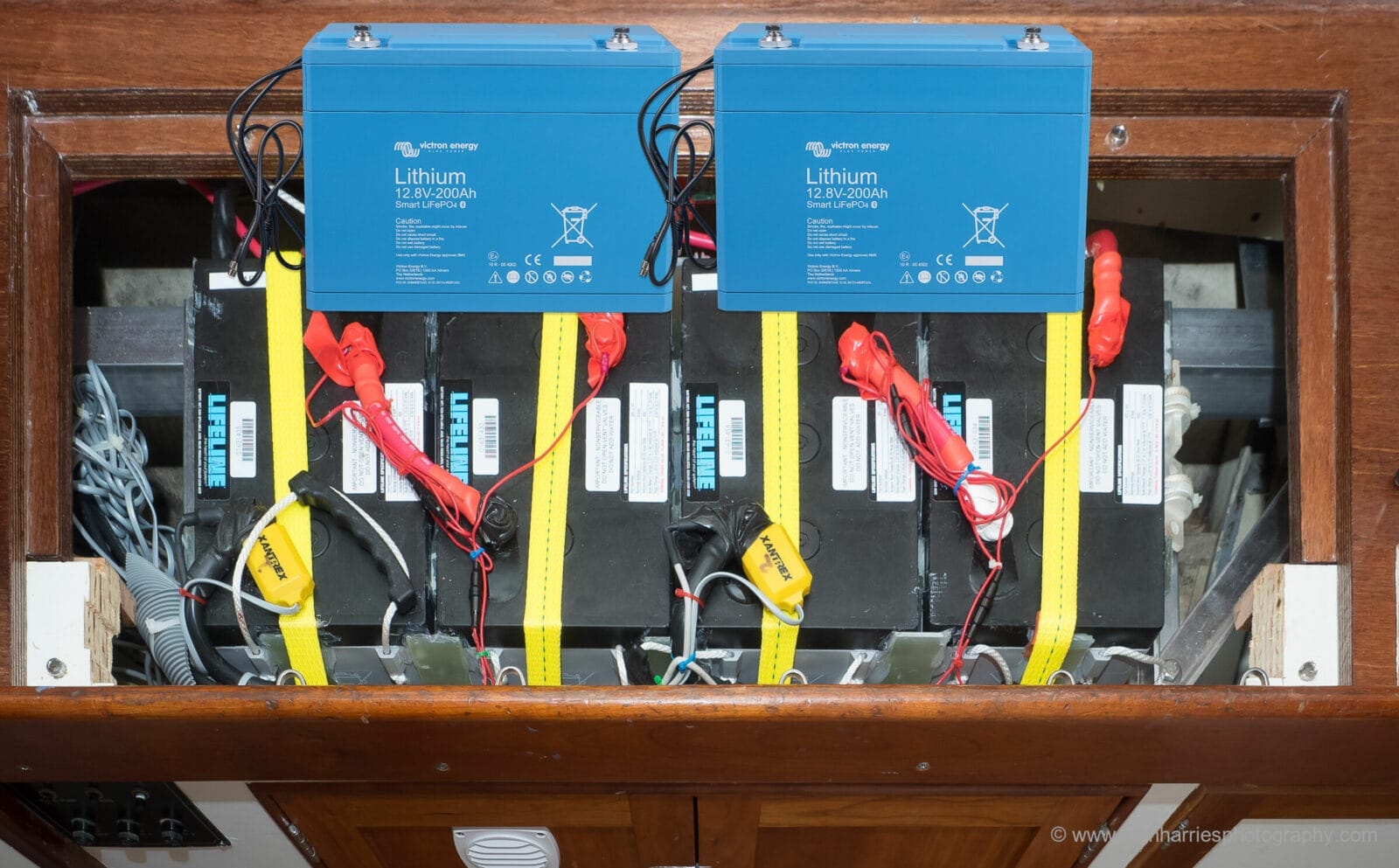
In this Tip I’m building on the last Tip in which I concluded that huge battery capacity makes little sense for most usage profiles.
It’s tempting when replacing a lead-acid bank with lithium to simply default to installing all the lithium capacity that will fit where the lead-acid batteries were. And indeed that might make sense if the boat had far too little battery capacity in the first place.
But defaulting to that strategy without doing a bit of basic math could cause us to not only spend way more money than we need to, but also to forgo a wonderful benefit of lithium batteries.
Here are a couple of rules of thumb that will help when deciding how much lithium capacity we should install in place of lead acid:

Hi John,
Looking at the picture of the AGM battery bank and parsing the capacity and weight numbers you presented had me scratching my head. The batteries appear to be Lifeline GPL-31T, 12V at about 100AH and 29kg each. Were you regularly exercising these to 60% DOD (depth of discharge), or are there more batteries in the bank not shown in the picture?
When replacing FLA or AGM with Lithium, I think it is important to consider reserve capacity. For example, if you are routinely using 30% DOD in your deep cycle FLA battery bank (discharging to 50%, recharging to 80%), there is still another 30% usable capacity in the battery bank (discharging from 50% to 20%), albeit at a cost in battery cycle life. That 30% could be very useful and buy some time in a non-normal usage profile when, for example, the alternator packs it in or the engine won’t start. If you size lithium at 70% DOD (discharging to 20%, charging to 90%) for your normal usage profile, there is precious little capacity left for a non-normal situation.
In my usage profile, I would likely replace the FLA with approximately the same rated AH capacity in lithium. This would still result in a significant size and weight reduction. And yes, if the picture in your post is indeed the whole battery bank, that is exactly what you recommended.
Hi Barry,
The old bank in the photo is four 400 AH 6 volt batteries in two series strings making 800 Ah at 12 volts.
I used conservative 30% of rated capacity for usable capacity for lead acid and 70% for lithium. Sure, one can use different factors for this, and we should take that into account when calculating bank size, but for the point I was making here it’s not material.
Also, I don’t agree that we need a lithium bank that big to account for the scenarios you mention. To me that’s losing part of one of the biggest benefits of lithium and if we think like that over all systems we will end up with a boat that’s more heavily loaded than optimal, or at least optimal for me.
Most boats have other charging sources (solar) than the engine, so I would not size the lithium bank that high just to cover an eventuality like an alternator failure, particularly since I believe that all offshore voyaging boats should carry a spare alternator.
Anyway, sure I can see your thinking, but it does not change the base point of this tip: don’t just default to filling all the space of a lead acid bank with lithium.
Hi Barry,
I agree with John about the numbers here.
Also, if you count the 30% of capacity from 50% to 80% DoD with lead acid, you can also count 30% extra capacity on the lithium batteries. The top 10% from 10 to 0% DoD (100% charged) are very easily available, as they charge just as fast all the way up, as opposed to LA. The reason for avoiding it is just longevity. The last 20% from 80% to 100% DoD (empty, 0% charge level), is also easily available with a very minor longevity penalty. Going to 80% DoD with LA is also acceptable occasionally, but will harm the batteries significantly more than 100% DoD will with lithium.
On top of this, LFP lithium has a very flat voltage curve and minimal voltage sag. That means the “empty” lithium can do heavy work, which the LA at 80% DoD (20% SoC) can not.
I really think getting a too big bank can become a problem rather than a benefit. That’s especially the case with lead acid, which MUST be kept pushing at totally full with short intervals. Lithiums don’t need that, depending on the system design regarding balancing, but there’s very little benefit from a bigger bank than we can reliably charge while out there.
I think one of several useful metrics is to look at how much solar charging we can realistically expect on an AVERAGE day while cruising like we plan to do. That average day should in my opinion be sufficient to get the battery bank from the minimum we want it at to the maximum we want it at. If the bank is too big for that, we need more solar or less battery capacity.
Hi Stein,
I think if we limit ourselves to a bank that can be fully recharged in a single day from solar, we should not have a boat that derives a lot of its charging from solar. If you look at the article on balancing battery bank size and solar(https://www.morganscloud.com/2023/01/24/balancing-battery-bank-and-solar-array-size/), the “optimal” ratio for that set of loads and weather is a 250Ah @ 12V bank with a 12A solar panel. Since there is solar involved, I am going to call it 50% usable capacity (50% SOC to 100% SOC) which would be 125 Ah. I just looked and there is 1 day with a little over 90Ah potential (assumes that the batteries will accept it) and everything else is 74Ah potential and below with the average being 50Ah/day of potential solar generation. In this case, the optimum is something like +70% of the battery sizing you suggest and that ignores the fact that as the solar is trying to recharge, there are still loads. If we were to take away some battery, then we would fall off the battery capacity cliff and if we tried to make this up with solar, we would need to add a huge amount as we would need significant solar output on poor weather days. From a windage and weight placement standpoint, solar is much worse to add for most boats. Alternatively, we could use an generator or the main engine. For what its worth, on our bank the battery usable capacity to solar good day output ratio is 3X although we have a bit more battery than we need due to real world size availability.
Yes, in the example the batteries are not getting to full every nice day but they are getting there often enough that the cycle life is still very good. I don’t think it makes sense to chase the exact number of lab cycles, we need to compromise between ultimate bank longevity and size and I think the example given is a reasonable compromise assuming you throw in equalization from time to time.
On the other hand, the only penalties to adding more battery capacity are weight, size and cost. If we increase the capacity and keep everything else constant, the average SOC will actually go up assuming that you were able to stay charged in the first place. You can also slightly decrease your charge source potentials as the batteries will be able to hold you over for longer until you have something like a longer motor. Again, we need to compromise and to me, there is not a benefit from going to a battery capacity beyond what is described above and the weight and size penalty is significant. To John’s point, if you go from a good lead acid solution to a lithium solution, you should absolutely take advantage of the higher energy density, it is one of the main reasons for doing it.
Eric
I agree. I replaced 900 ah of AGM batteries with two 300 AH Lifepo4 batteries and its still to big. I should have gone with two 200AH. Now I need to actively manage the battery bank to get proper cycling of batteries. I have 400 watts of solar and on some days I need to shut it off to run the batteries down. Battery choices were limited in Mexico which is why I went larger than ideal. Still the weight and space savings were fantastic.
I’ll just leave one anecdote here that frames my thinking. After replacing my 300ah AGM bank with 300ah of LiFePo4, the new batteries only “cycled” a sum total of about 20 times throughout a 9 month season (three of which I lived on continuously away from the marina). I didn’t calculate my loads but they were basically relegated to running my frig 24/7 and a laptop with external monitor 12 hrs/day. LED lights and fans add a minor amount. 400+ watts of solar was plenty, even shaded, to keep my batteries from ever dipping below 50% SOC. Not sure how the manufacturer’s app counts a cycle but I could’ve gotten away with 200ah of lithium for sure, and only suffered a little perhaps on long, cloudy passages with higher loads (instruments, AP, radar, etc). I’ll apply this lesson when I eventually upgrade the lead acid bank on my new boat.
Hi Jesse,
Thanks for the real world numbers. Always useful.
3kwhr is a bit light on for modern loads. As a family boat we use 10-15kwhr / day with no propane cooking, water heating and desalination and tech. I prefer to have 1.5 days capacity available if possible.
Hin Paul,
At least in my world that’s huge usage. 15 kWh is 1250 Ah at 12 volts! Each to their own, but if I were burning through that much power in a day I would be considering it a problem that requires fixing. That 400% to 500% more than Phyllis and I typically used on a very comfortable 56 foot boat.
48v. 61ft fast cat (1993) w 5kw solar, 30kwhr batt, 10kva inverter and 9kw alternator (rarely used). With electric cooking we treat it like a house. Efficient appliances but things like electric BBQ, electric hot water, dishwasher etc. Just a different non scarcity power mindset from solar and lithium.
Most apartments all electric would use about 15kwhr/day with a family.
Hi Paul,
Sure, each to their own, but that further highlights the very different ways you and I think. To me emulating an apartment on a cruising boat is a fundamental design error.